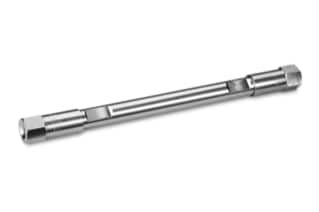This application note describes the analysis of capsaicin and dihydrocapsaicin by HPLC by using a modular chromatographic system.
Capsaicin (Figure 1), (8-methyl-N-vanillyl-6-nonenamide) is an active component of chili peppers, which are plants belonging to the genus Capsicum. Capsaicin and several other related compounds such as dihydrocapsaicin (Figure 1) are called capsaicinoids and are produced as secondary metabolites by chili peppers. Pure capsaicin is a hydrophobic, colorless, odorless, crystalline-to-waxy compound.
Because of the burning sensation caused by capsaicin when it comes in contact with the mucous membranes found in the mouth, it is frequently used in food products to give them added spice or heat (pungency). In high concentrations, it can also cause a burning effect on sensitive areas, of skin such as the backs of fingers and hands, from handling and processing chili peppers.
Capsaicin can also now be found in topical lotions, where it acts as a pain reliever for minor aches and pains that may be associated with backaches, strains, sprains, and arthritis.
The degree of heat found within a food can be measured on the Scoville scale, however, high performance liquid chromatography (HPLC) analysis is a more accurate method of calculating heat pungency caused by capsaicin content in a food product.
This application note describes the analysis of capsaicin and dihydrocapsaicin by HPLC by using a modular chromatographic system comprised of a Waters 2707 Autosampler, 1525 Binary HPLC Pump, 2489 Dual Wavelength UV/VIS Detector and 1500 Series column oven. The resulting method possessed excellent area count reproducibility, retention time reproducibility, reliable quantitation, and low carryover performance, demonstrating the excellent performance of this modular system.
Capsaicin and dihydrocapsaicin were extracted by the following procedure from six commercial hot sauces. A 10 mL aliquot of each hot sauce was transferred into a 50 mL centrifuge tube, 2 mL of dichloromethane was added, and the tube and its contents were vortexed for approximately 1 minute. Then the test tube was placed in a centrifuge for 10 minutes at 3000 RPM, following centrifugation, 1 mL of extract was withdrawn from the tubes and evaporated to dryness using nitrogen gas. The material left in the test tube was then reconstituted in 2 mL of methanol. Sample extracts were passed through a 0.45 mm syringe tip filter prior to HPLC analysis.
|
HPLC system: |
Waters 1525 Binary HPLC Pump 2707 Autosampler |
|
Column: |
Waters Atlantis T3 3 μm, 4.6 x 100 mm |
|
Detector: |
2489 Dual Wavelength UV/Vis |
|
Data: |
Empower 2 Software |
|
Sample temp.: |
Ambient |
|
Column temp. : |
40 °C |
|
Injection volume: |
25 μL |
|
Mobile phase A: |
Water |
|
Mobile phase B: |
Methanol |
|
Flow rate: |
1.50 mL/min |
|
Time |
%A |
%B |
|---|---|---|
|
60.00 |
40.0 |
|
|
8.00 |
15.00 |
85.0 |
|
10.00 |
1.00 |
99.0 |
|
13.00 |
1.00 |
99.0 |
|
15.00 |
60.00 |
40.0 |
A total of six samples were analyzed; all were commercial-grade hot sauces bought from a local supermarket: two red pepper-based, two habanero pepper-based, one jalapeno pepper-based and one cayenne pepper-based sauce.
Injections of sample extracts from each sauce were bracketed by six replicate injections of capsaicin and dihydrocapsaicin standards (Sigma-Aldrich Chemical Co.). Methanol/water blanks were injected throughout the sample set to assess carryover. Examples of the chromatograms for the two standards and a sample are found in Figures 2, 3, and 4.
The assay reproducibility with this methodology for capsaicin and dihydrocapsaicin showed a %Relative Standard Deviation (%RSD) for area less than 0.30%, and a %RSD for retention time less than 0.10%.
It was confirmed that capsaicin and dihydrocapsaicin were present in all of the hot sauces analyzed. The amounts were calculated from a six-point linear calibration curve and are displayed in Table 1. Standard concentrations ranged from 0.028 to 0.84 mg/mL for both compounds. Excellent linearity was observed for both capsaicin (R2= 0.999963) and dihydrocapsaicin (R2= 0.999961), (Figures 5 and 6).
Using a wash solvent of 90:10 water/methanol, extraction solvent blanks run after the most concentrated standard showed no measurable carryover (Figure 7), proving the methodology has a low probability of showing false positives.
The Scoville Organoleptic Test was the first method used to determine pungency of a pepper,1 however it is very imprecise due to the fact that it relied on human subjectivity. In Wilbur Scoville’s method, a solution of the pepper extract is diluted in sugar water until its heat is no longer detectable to a panel of usually five tasters; the degree of dilution gives its measure on the Scoville scale.
For example, capsicum, sweet pepper, or a bell pepper (all containing no capsaicin) all have Scoville ratings of zero, meaning no heat is detectable even undiluted. However, when the hottest chiles – such as a habanero pepper – have a rating of 200,000 or more, this extract has to be diluted 200,000-fold before the capsaicin present is undetectable.2
According to Tainter and Grenis,2 a measurement of one part capsaicin per million (1 mg/kg) is the equivalency of about 15 Scoville units. Using HPLC, this approximation gives 20 to 40% lower amounts than the Scoville method would have.
With HPLC, manufacturers can now accurately measure the amount of capsaicin in their products, whether it be a hot sauce or a topical lotion used as a pain reliever. By using the described HPLC method, a consumer product manufacturer can more accurately monitor and control the Scoville rating in each batch of product.

720002753, July 2008